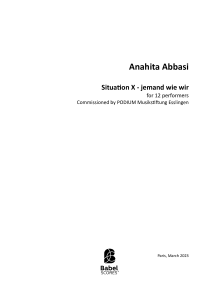Métal Re-sculpté
9,27 €
Digital version (+0,00 €) instant download
Printed format (+14,80 € printing and shipping). Colissimo7-14 days aprox.
When you buy a score, you can contact the composer right here!
Specifications
Region
Europe
Estimated Duration
11 - 15min
Date
2009
ISMN : 979-0-2325-1255-6
In Stock
Notes on this piece
With the use of electronics, Métal Re-sculpté, for tubax (or baritone) saxophone & real time electronics, sculpts, combines and reshapes the sounds of the saxophone, to create new sonic objects. These objects are carefully proportioned by giving more weight to quiet fragile sounds and less to heavy loud ones. It is through measuring their perceptual, as well as temporal scale, that balance is created in this metallic sonic sculpture. There are several dichotomies framed inside this piece, such as: loud/soft, free/fixed, low/high. Although these opposites are exploited and pitted against each other, it is the fine gradients between them that is explored. Characteristics of the sounds are dissected, and then connected to each other through either superimposition, juxtaposition or re-contextualization. For example the quiet tapping sound in the opening, is transformed into as a ruckus rumble later on, merely though the use of amplification. Or, with the use of improvisation, there are moments where the performer is free to respond to the computer, while at other times constrained to certain choices, or must respond to notational constraints.
Add to a playlist
- Login to create your own lists
With the use of electronics, Métal Re-sculpté, for tubax (or baritone) saxophone & real time electronics, sculpts, combines and reshapes the sounds of the saxophone, to create new sonic objects. These objects are carefully proportioned by giving more weight to quiet fragile sounds and less to heavy loud ones. It is through measuring their perceptual, as well as temporal scale, that balance is created in this metallic sonic sculpture. There are several dichotomies framed inside this piece, such as: loud/soft, free/fixed, low/high. Although these opposites are exploited and pitted against each other, it is the fine gradients between them that is explored. Characteristics of the sounds are dissected, and then connected to each other through either superimposition, juxtaposition or re-contextualization. For example the quiet tapping sound in the opening, is transformed into as a ruckus rumble later on, merely though the use of amplification. Or, with the use of improvisation, there are moments where the performer is free to respond to the computer, while at other times constrained to certain choices, or must respond to notational constraints.
Instrumentation
Tubax Saxophone|electronics|
Recording
Thomas Berthemeley - April 2010. IRCAM - Paris
Score Details
Format - A4 / US Letter
Pages - 12
Pages - 12
Similar Pieces





